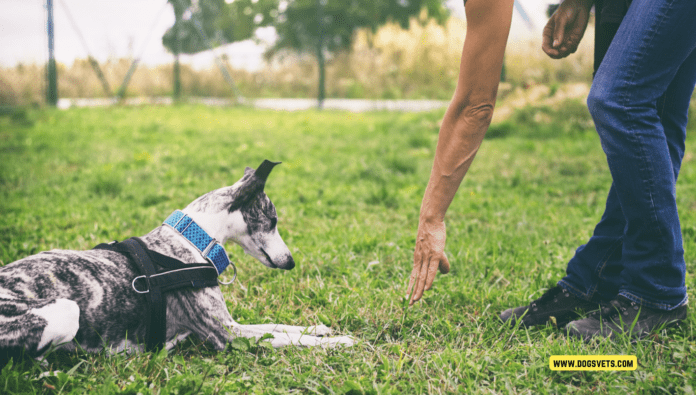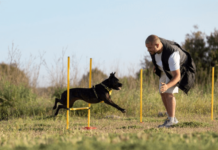Last Updated on December 6, 2023 by Dogs Vets
How to Train a Puppy for Obedience
In this comprehensive guide, we’ll delve into the art of training a puppy for obedience.
Whether you’re a new pet parent or looking to improve your furry friend’s manners, we’ve got you covered. Our step-by-step approach ensures that your puppy becomes a well-behaved companion.
Understanding the Basics
Building a Strong Foundation
First things first, let’s establish the groundwork for successful obedience training. Begin with understanding your puppy’s breed, temperament, and needs.
The Power of Positive Reinforcement
Discover the effectiveness of positive reinforcement techniques. Learn how to reward good behavior to encourage your puppy to repeat it.
Communication is Key
Mastering canine communication is vital. We’ll explore body language, tone of voice, and cues to ensure your puppy understands your commands.
Training Techniques
Crate Training
Explore the benefits of crate training and how it aids in housebreaking and creating a safe space for your puppy.
Basic Commands
Teach your puppy essential commands like sit, stay, and come. We’ll provide step-by-step instructions for each.
Leash Training
Learn the secrets to leash training and turn your walks into enjoyable experiences for both you and your pup.
Challenges and Solutions
Addressing Common Behavioral Issues
We’ll tackle common puppy problems like chewing, barking, and digging, providing practical solutions.
Basic Obedience Training for Puppies
When you bring a new puppy into your home, the early weeks can be overwhelming. There’s a lot to do, from shopping for supplies to setting expectations for your furry companion.
One of the most crucial steps in this journey is puppy obedience training.
Choosing the Right Training Approach
When it comes to puppy obedience training, several factors should influence your decision:
1. Training Methods
Ensure you choose positive reinforcement training methods that reward your puppy for making the right choices while avoiding punishment or negative reinforcement[1].
2. Training Location
Decide between home training and group classes. Home training allows for personalized focus, while group classes help your puppy learn to focus amid distractions[2].
3. Instructor Selection
Select an instructor whose teaching style aligns with your beliefs and who encourages a safe and effective learning environment for both dogs and owners[2].
Types of Obedience Classes
Training schools offer various classes for puppies, starting as young as eight weeks. These classes can progress from basic puppy training to certifications like AKC STAR Puppy and AKC Canine Good Citizen[3].
Essential Equipment
Before attending your first class, make sure you have the necessary equipment, such as a flat buckle or snap collar and a four-to-six-foot snap-on leash. For larger, stronger dogs, consider using a body harness[4].
Beyond Training
A good training class should also cover important topics like socialization, dog behavior, and grooming. Proper socialization during puppyhood and understanding your dog’s body language are crucial[5].
Addressing Common Training Issues
Training your puppy involves addressing common behavior issues like jumping, nipping, and inappropriate sniffing. Consistency is key, and positive reinforcement should be used to encourage desirable behaviors[6].
Obedience for All Dogs
Remember that obedience training is essential for all dogs, providing mental stimulation and physical exercise. Basic commands like sit, stay, and come are fundamental for a well-behaved pet[7].
Finding a Dog Obedience Trainer
Seeking a professional trainer? Consider resources like AKC Training Clubs and AKC Canine Good Citizen Evaluators. You can also ask fellow dog owners for recommendations[8].
With this comprehensive guide to puppy obedience training, you’re well-equipped to start your puppy’s journey toward becoming a well-behaved and happy companion.
15 Obedience Training Tips For A Puppy
Training a puppy for obedience is an essential part of ensuring they grow up to be well-behaved and well-adjusted dogs.
Consistency, patience, and positive reinforcement are key principles in puppy obedience training.
Here’s a step-by-step guide to help you train your puppy for obedience:
- Start Early: Begin training as soon as you bring your puppy home, ideally around 8-12 weeks old. Puppies are like sponges at this age and can learn quickly.
- Basic Commands:
- Sit: Teach your puppy to sit on command. Hold a treat above their head and slowly move it back over their head, which will naturally cause them to sit. Say “sit” as they do, and reward with the treat.
- Stay: After your puppy has mastered sitting, you can move on to “stay.” Hold your hand up as a stop sign and say “stay” while taking a step back. Gradually increase the distance and duration as they improve.
- Sit: Teach your puppy to sit on command. Hold a treat above their head and slowly move it back over their head, which will naturally cause them to sit. Say “sit” as they do, and reward with the treat.
- Positive Reinforcement: Use treats, praise, and affection as rewards when your puppy obeys a command. Be consistent and reward immediately after they perform the desired behavior.
- Clicker Training: Consider using a clicker to mark the exact moment your puppy does the right thing. This can help reinforce good behavior.
- Consistency: Everyone in your household should use the same commands and reward system to avoid confusion for your puppy.
- Socialization: Expose your puppy to various people, dogs, and environments from an early age. This helps them become well-adjusted and less fearful or aggressive in new situations.
- Crate Training: Teach your puppy to associate their crate with safety and comfort. This is helpful for housebreaking and when you need to confine them.
- Potty Training: Consistency is crucial for potty training. Take your puppy outside frequently, especially after eating, drinking, or waking up. Praise and reward them when they go outside. Clean up accidents indoors without scolding.
- Leash Training: Get your puppy used to a leash and collar. Start with short walks in a quiet, familiar area and gradually introduce them to new environments. Teach them to walk beside you without pulling.
- Distraction Training: Train your puppy to focus on you by gradually introducing distractions during training sessions. This helps them obey commands even when there are tempting distractions around.
- Obedience Classes: Consider enrolling in obedience classes with a professional trainer. These classes can provide structured training and socialization opportunities for your puppy.
- Be Patient: Remember that puppies have short attention spans, and they may not always get it right the first time. Stay patient, and never use physical punishment or yell at your puppy, as this can lead to fear and aggression.
- Exercise and Mental Stimulation: Puppies need plenty of physical exercise and mental stimulation. Provide toys, puzzles, and playtime to keep them engaged and tire them out.
- Regular Routine: Stick to a regular schedule for feeding, bathroom breaks, and training sessions. Predictability can help your puppy learn faster.
- Gradual Progress: As your puppy matures, you can introduce more advanced commands and expectations. Continue reinforcing the basics while adding new challenges.
Conclusion
In conclusion, training a puppy for obedience requires patience, consistency, and love.
By following the techniques outlined in this guide, you’ll build a strong bond with your furry friend and ensure a well-behaved companion for years to come.
Remember that every puppy is unique, and the training process may vary in duration. Consistent, positive reinforcement-based training methods will help your puppy become a well-behaved and obedient companion over time.
If you encounter specific behavioral issues or challenges, consult with a professional dog trainer or behaviorist for guidance.
FAQs
How long does it take to train a puppy for obedience?
Training duration varies but can take several weeks to months. Consistency is key.
What treats work best for positive reinforcement?
Use small, soft treats that your puppy loves to motivate them during training.
Can older dogs be trained for obedience?
Yes, dogs of all ages can learn new tricks with patience and dedication.
Should I hire a professional dog trainer?
It’s an option, but with the right guidance, many pet parents can successfully train their puppies at home.
How often should I train my puppy?
Short, frequent sessions are more effective than long, infrequent ones. Aim for 10-15 minutes several times a day.
Is punishment a good training method?
No, punishment can create fear and aggression. Positive reinforcement is a more effective and humane approach.
Where can I find additional resources for puppy training?
Check local dog training classes, online tutorials, and books for further guidance.
Verified Sources:

















